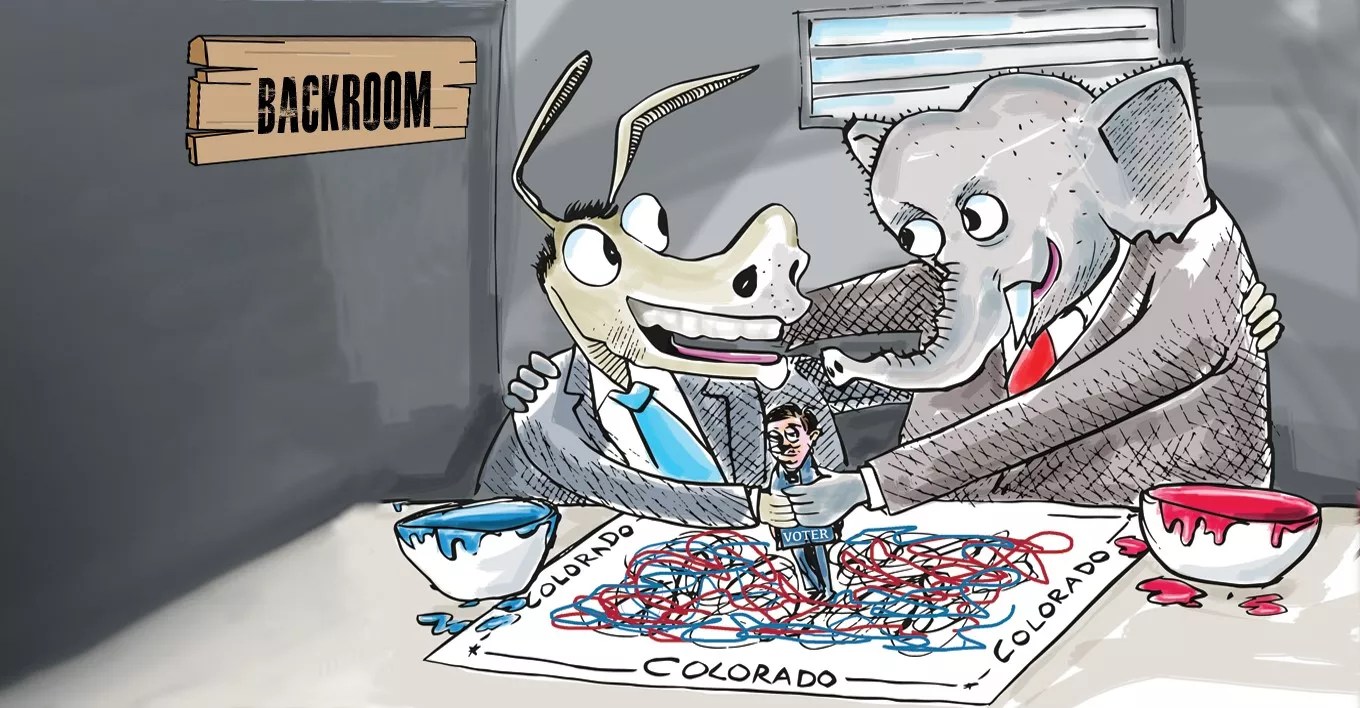
Courtesy of Fair Districts Colorado

Audio By Carbonatix
Former state representative Kathleen Curry knew there would be consequences for dropping her Democratic party affiliation in 2009, in the middle of her third term as a Democrat in the Colorado House. Shortly after, Curry – now unaffiliated – applied to sit on the Colorado Reapportionment Commission, which draws and approves the state’s election districts.
But the Democrats and Republicans who controlled the board wouldn’t consider it.
“At that point, I knew that we were out of whack,” says Curry. “[Unaffiliated voters] were left out.”
So when Curry was contacted by Fair Districts Colorado, a coalition of two former governors, over twenty current and former elected officials, and grassroots groups that are bidding to upend Colorado’s districting process, she was happy to sign on.
On Wednesday, September 6, Fair Districts Colorado filed three ballot initiatives with the secretary of state’s office that will attack what they believe is widespread gerrymandering of election districts. If the initiatives receive enough signatures, they will be placed on the November 2018 ballot for Colorado voters to consider, and could have major implications for one of the most powerful elements of state government.
The ballot initiatives target the process by which the state legislature draws its own districts, which takes place every ten years. The Colorado Reapportionment Commission is made up of eleven Democratic and Republican politicians, who get to draw the state and federal election district maps – and this is done with political motivations along party lines, according to former deputy secretary of state Bill Hobbs, who has endorsed the initiatives. With the party in power in charge of the process, the result is gerrymandered districts designed to give one party an edge come election season.
“Our districts in Colorado don’t look gerrymandered in the traditional sense….but the point here is that gerrymandering is not just about the shape of the district, it is about the outcome.”
Fair Districts Colorado will ask voters to consider removing the political aspect of that board. One ballot initiative would bump the number of boardmembers from eleven to twelve while changing the sitting members from politicians to nonpartisan staff from the Colorado Legislative Council. It would also require the board to be made up of four Democrats, four Republicans and four unaffiliated voters, and prevent any mapping of state districts without a supermajority vote of eight that includes one of those unaffiliated members.
Voters will also be asked to consider a looser initiative that would implement parts of the plan, along with a third initiative to establish a separate board for mapping Colorado’s six congressional districts, which has never been done before.
According to former Democratic state senator Ron Tuba, who is involved in the campaign, election results show that both parties have used the districting process to make most state districts easy to win. Out of the 65 state house districts, he says, only four are competitive – and only three of those four districts changed political party affiliation in the past ten years. The same is true for state Senate districts and the six congressional districts in the state, where only the 6th Congressional District, which includes Brighton, Aurora and Littleton, is embroiled in a contested campaign for 2018.
“Our districts in Colorado don’t look gerrymandered in the traditional sense….but the point here is that gerrymandering is not just about the shape of the district – it’s about the outcome,” says Tuba. “The two major parties have done a poor job with this process, making a mockery out of it, ignoring public input [and] violating straightforward government criteria for redistricting,” he adds.
Worse, notes Bill Hobbs, is when the districting board can’t agree on how to draw election maps. “The General Assembly is supposed to do it, but for the last several go-arounds, they’ve just failed to do it,” says Hobbs, who was deputy secretary of state from 1999 to 2011. That year, the failure landed the plans in district court, where a judge required both Democrats and Republicans to submit respective districting plans. The judge ultimately approved the Democratic redistricting plan amid condemnations from Republicans.
“A lot of people would say that in that process, the Democrats come out pretty well,” says Hobbs. “And from what my understanding is, the parties really did capture that process.”
If approved, the plans would be implemented before Colorado’s next redistricting, in 2020.
Fair Districts Colorado is surprisingly bipartisan, having received endorsements from two former governors, Republican Bill Owens and Democrat Dick Lamm, as well as three former speakers of the state House and dozens of current and former state officials from both sides of the aisle. The League of Women Voters of Colorado and the Centrist Project, two advocacy groups, have also signed on.